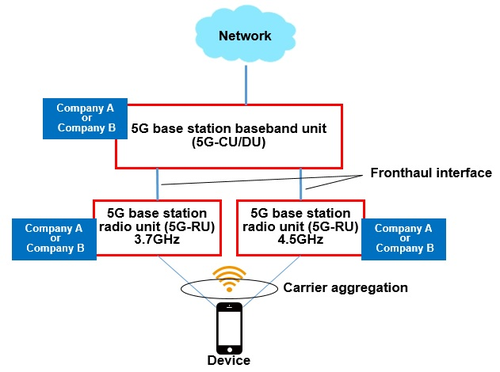
A Japanese trio of NTT Docomo, Fujitsu and NEC announced today "what they believe" is the world's first carrier aggregation using 5G frequency bands in a "multi-vendor" RAN.
Prising open the fronthaul, which links broadband base units with remote radio heads, is high on the agenda of the O-RAN Alliance.
Figure 1: Carrier aggregation using 5G-frequency bands on multi-vendor RAN 
By throwing carrier aggregation (CA) into the open 5G fronthaul mix – CA, of course, is an established tool for boosting capacity of LTE networks – is another show of progress by open RAN proponents.
In what was described as "interoperability verification," the results of which were announced at the end of a five-day O-RAN Plugfest web conference, "5G frequencies" in the 3.7GHz and 4.5GHz bands were combined for CA purposes. Download speeds of up to 4.2Gps, indicated the trio, will be possible.
Top brass from each of the three participating companies gave approving quotes about the CA breakthrough.
Atsuo Kawamura, president of NEC's network services business Unit, pretty much summed up the feeling among them. "The success of carrier aggregation in the 5G bands is a critical step in the ongoing enhancement of 5G network performance," he said.
Docomo pointed out that it already has "multi-vendor" open RAN in place, which connects baseband units and remote radio units (again, using Fujitsu and NEC, and based on O-RAN's open fronthaul specifications). The same system configuration was used to achieve 5G CA.
When the CA enhancement might become commercially was not made clear.
Are CPRI days finally numbered?
Much to the chagrin of those wanting to shake up traditional RAM supply chains, dominated by so-called monolithic vendors, industry has relied on the common public radio interface (CPRI) standard, and its successor, enhanced CPRI, for fronthaul.
Want to know more about 5G? Check out our dedicated 5G content channel here on
Light Reading.
Both have been typically implemented in a semi‑proprietary, non-interoperable way by large equipment vendors. How quickly the likes of Ericsson and Nokia might take a more open approach to fronthaul is uncertain.
Fredrik Jejdling, head of business area networks at Ericsson, told Light Reading earlier this year that open RAN technology was not sufficiently mature to warrant wholehearted support. "What we see now is that, with O‑RAN specifications, the performance of those interfaces is not to the extent of the interfaces that are built on CPRI standards," he said.
Related posts:
— Ken Wieland, contributing editor, special to Light Reading
Read more about:
AsiaAbout the Author(s)
You May Also Like



.jpeg?width=300&auto=webp&quality=80&disable=upscale)







